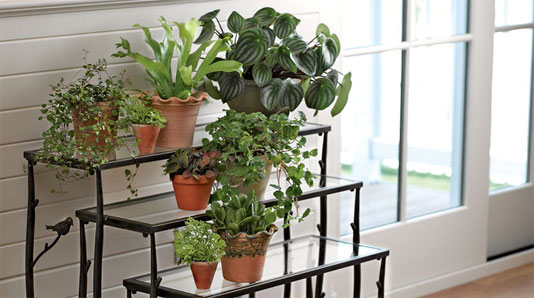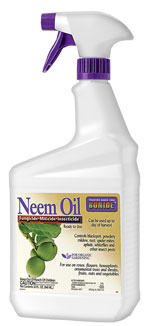






Healthy houseplants need good air circulation, so it's important that they're not crowded. The Nesting Branch Plant Stand makes it easy to adjust spacing to accommodate growing plants.
MOST gardeners find growing a great tomato or a beautiful bed of zinnias is easier than keeping houseplants alive. It seems that one day they're fine and the next they're dropping leaves and are infested with aphids, mealybugs or spider mites.
It's actually not that difficult to keep houseplants happy, but you do need to pay attention to their basic needs, and take care of any pest problems right away. Here are some suggestions to help you have a green thumb indoors as well as out!
All plants need food, water and sunlight to survive, but different plants require different amounts of each. This is just as true with houseplants as it is for the plants in your garden. For example, ficus trees generally thrive with indirect light and moist soil, whereas cacti require bright light and dry soil.
Make sure you choose houseplants that will thrive on the amount of light you can provide. Healthy plants will be able to ward off pests and disease much better than weak plants.
Indoor plants also need regular fertilizing to maintain healthy growth. A great all-around fertilizer that can be added right to your watering can is Plant Health Care for Seedlings and Houseplants. It is a balanced formula that contains a 6-12-6 fertilizer, humic and amino acids, and vitamins. As a general rule, most houseplants should be fertilized from January through September, and should then be allowed to "rest" for a few months.
Alternating periods of drought and flood can really stress a plant’s root system. Most plants like having their roots consistently moist, but not wet. Some plants prefer to dry out a bit between waterings. For new plants, check the care label or consult a good indoor plant book. This will help you determine the right watering routine. Self-watering planters make it easier to keep plants watered.

This natural, multipurpose pest control spray belongs in the tool shed of every gardener. Neem Oil Spray has natural potassium salts and potent neem tree oil, it works on a wide variety of pests including aphids, mites, white flies, flea beetles and earwigs. It even kills scale on your houseplants and tent caterpillars that destroy your trees. Also controls powdery mildew. Safe to use on indoor and outdoor plants, right up to the day of harvest.
When a houseplant gets attacked by an insect pest, the problem can quickly spread to other plants. Preventing insects from entering your home is key to indoor insect control.
Check houseplants for disease or insects before you buy them. Then isolate them for a couple weeks, just to make sure there are no problems. Each time you water your plants, inspect both sides of the leaves for signs of pests or disease. If you suspect anything, isolate the plant from your other plants until you have eliminated the problem.
It is also a good idea to wash the leaves of your plants several times a year. Dust and grime on houseplants doesn't just look bad; it is also bad for the health of the plant. Dust clogs the "pores" of plant leaves, making it difficult for the plant to respirate. In addition, dust filters sunlight before it reaches the plant, decreasing the amount of photosynthesis the plant can undertake. Dust and grime can also attract and harbor spider mites and other insect pests.
Wash smooth-leaved houseplants with a moist, soft cloth and some insecticidal soap, such as Neem Oil Spray. For plants with many small leaves, use a hand sprayer or sink sprayer to douse them with water. Another option is to place the plant under a shower head and spray it. In all cases, the water should be lukewarm — not cold or hot. You can add a few drops of mild liquid dishwashing soap or insecticidal soap to the water as well.
Never use a feather duster to clean plants, because dusters can easily transfer tiny insects or eggs from one plant to another.
Copyright © www.100flowers.win Botanic Garden All Rights Reserved